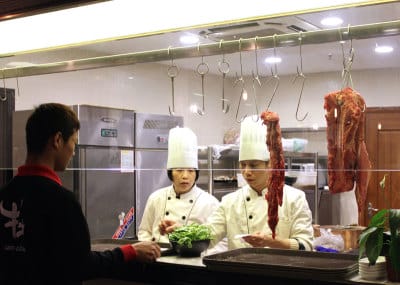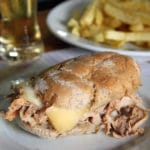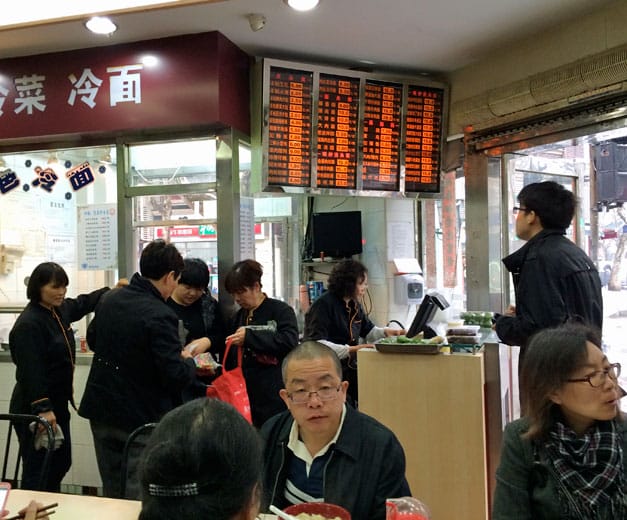Editor’s note: Soup Week at Culinary Backstreets heats up with our second installment in the series, in which our Shanghai correspondent reports on a new hotpot specialist in Xuhui that takes extraordinary care in how it sources ingredients.
We’d just about given up on hotpot, what with last year’s scandals of rat meat parading as lamb and opiates mingling with the Sichuan peppercorn to give diners a real buzz. But 2014 has seen the trend of farm-to-table dining hit Shanghai in a big way, spurred on by these food safety concerns. The most recent entrant to the organic dining scene is the aptly named Holy Cow.
More than just a phrase made famous by Chicago Cubs announcer Harry Caray, Holy Cow is a healthy hotpot restaurant specializing in – you guessed it – beef, plus vegetables sourced from owner Anthony Zhao’s family farm. Loyal CB eaters might remember Zhao from his Shanghainese lunch hotspot Mi Xiang Yuan. The nongtang restaurant left the alleyways in late 2014, relocating to Shanghai’s deep south and serving as the first-floor anchor for the new hotpot restaurant. But while Mi Xiang Yuan’s larger cafeteria-style location is bustling at midday, it’s Holy Cow that draws the nighttime crowds with its healthy produce, fresh-never-frozen meat and bone broth cooked low and slow.
The foundation of any good hotpot restaurant is the soup base, and Holy Cow has 11 excellent options. We avoid the typical spicy option (麻辣, málà) – this stock is too good to hide beneath the brash flavors of numbing Sichuan peppercorns. Instead, we get the beef brisket broth with pickled vegetables (酸菜牛腩锅, suāncài niún䘠n guō). Thick with chunks of tender meat and peppers that add just a tiny spicy kick, this hearty concoction is made with bones simmered for hours and laden with extra edible goodies like sweet jujubes and wheels of American corn. After we’ve eaten every last scrap of meat and produce, we turn off the propane and dole out bowls of pure reviving broth to finish our meal.
 While the broth alone is worth the trip south of Xujiahui, Zhao has also sourced excellent meat and produce to make sure every bite is outstanding. Most of the time when you order beef at hotpot, you receive dainty cigar rolls of meat – a clear indication that the paper-thin cuts have been machine-sliced while frozen. Holy Cow’s slabs of beef hang fresh in the open kitchen so diners can watch the meat being sliced to order. Most of the beef comes from the yellow cattle of Dalian province, but there’s a high-end option too: grain-fed Kobe-style beef from Qingdao (青岛谷饲雪花肥牛, Qīngd⠠o g⤶ sì xuěhuā féi niú). Ruby-red beef fillet (热气手切牛菲力, rèqì shǒu qiè niú fēi lì) and strips of fatty rib eye (牛牛特色肥饼, niúniú tèsè féi bing) sit well within the hotpot comfort zone, but we think it’s worthwhile to branch out with an order of chest tendon (胸口捞片, xiōngkǒu lāo piàn). The white half dollars of connective tissue curl up into rich, crunchy bites when dipped in the broth.
While the broth alone is worth the trip south of Xujiahui, Zhao has also sourced excellent meat and produce to make sure every bite is outstanding. Most of the time when you order beef at hotpot, you receive dainty cigar rolls of meat – a clear indication that the paper-thin cuts have been machine-sliced while frozen. Holy Cow’s slabs of beef hang fresh in the open kitchen so diners can watch the meat being sliced to order. Most of the beef comes from the yellow cattle of Dalian province, but there’s a high-end option too: grain-fed Kobe-style beef from Qingdao (青岛谷饲雪花肥牛, Qīngd⠠o g⤶ sì xuěhuā féi niú). Ruby-red beef fillet (热气手切牛菲力, rèqì shǒu qiè niú fēi lì) and strips of fatty rib eye (牛牛特色肥饼, niúniú tèsè féi bing) sit well within the hotpot comfort zone, but we think it’s worthwhile to branch out with an order of chest tendon (胸口捞片, xiōngkǒu lāo piàn). The white half dollars of connective tissue curl up into rich, crunchy bites when dipped in the broth.
Produce is sourced with as much care as the beef, and the bulk of it comes from the family farm in Shanghai, which grows organic veggies from imported seed and uses Japanese farming techniques to improve soil fertility. To taste what’s freshest, we get the vegetable platter (太阳农庄有机菜拼盘, tàiyáng nóngzhuāng yǒujī cài pīnpán), which changes daily depending on what has just arrived in the kitchen. A recent visit included okra, watermelon radish, calabash and a field of leafy greens. We also love both varieties of handmade tofu, the crispy deep-fried skin (特色香炸豆腐皮, tèsè xiāng zhà dòufu pí) and soft white tofu (手工石蘑豆腐, shǒugōng shí mó dòufu) that soaks up all the broth for a creamy mouthful.
There are a few surprises on the menu: shiitake mushrooms (香菇, xiānggū) arrive at the table still “living” on the log they grew on, requiring a quick de-wooding of their stems before being thrown into the pot. Zhao, a Shanghainese native, also couldn’t resist adding his city’s signature dish to the menu: steamer baskets of soup dumplings. They arrive at the table raw, the long (bamboo steamers) just for show. Diners are meant to gently boil the sweet soup dumplings in the broth. Yep, that’s soup dumplings in soup for a meta dining experience. Libations include a couple of bottles of decent wine, plus some German beer. There’s also the option of adding medicinal ox penis (牛鞭, niú biān) to your broth – for virility, of course.
 June 7, 2022 Casa Guedes
June 7, 2022 Casa Guedes
Forget the famous francesinha. The best sandwich in Porto – arguably in the country – […] Posted in Porto May 2, 2023 Spring Gone Wild
May 2, 2023 Spring Gone Wild
One of the great joys of spring in Japan is anticipating the appearance of sansai, or […] Posted in Tokyo June 30, 2014 Fengyu
June 30, 2014 Fengyu
At noon, the line stretches out the door and there’s a noisy rumble of loud voices […] Posted in Shanghai
Published on December 30, 2014
Related stories
June 7, 2022
PortoForget the famous francesinha. The best sandwich in Porto – arguably in the country – can be found in a little 1970s tile-lined eatery; the unremarkable interior belies the iconic status of its most celebrated dish. Served up on the corner of Praça Poveiros, a square named after the fishermen from the storied maritime city…
May 2, 2023
TokyoOne of the great joys of spring in Japan is anticipating the appearance of sansai, or mountain vegetables. When cherry blossoms begin to flutter on warming breezes, hikers take to the hills to forage for the first wild edibles. Supermarkets mount special displays of packaged (and unfortunately often hot-house-raised) young sprouted leaves, shoots and tubers.…
June 30, 2014
Shanghai | By Lillian Chou
ShanghaiAt noon, the line stretches out the door and there’s a noisy rumble of loud voices inside the Ruijin Erlu and Nanchang Lu branch of Fengyu (丰裕), a neighborhood staple that has fed locals for decades deep in the heart of the former French Concession. According to Dianping, China’s most-visited food website, there are 35…


















































































